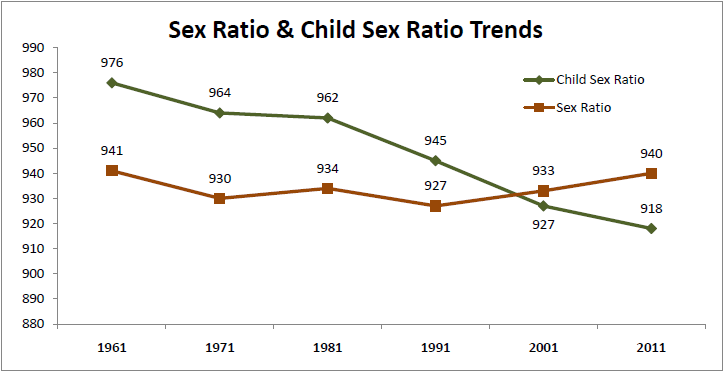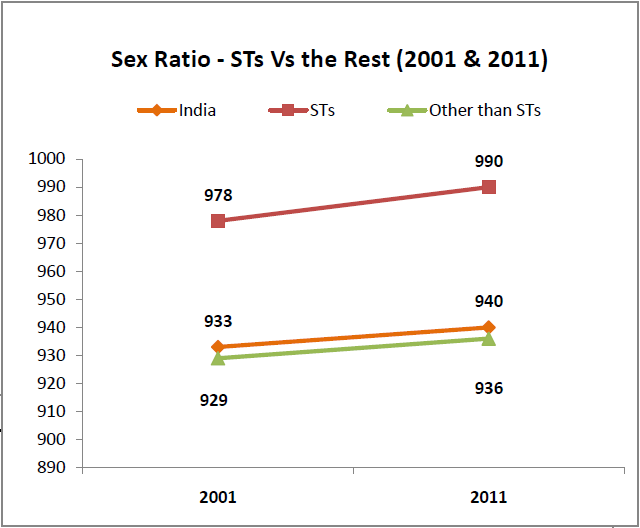[orc]The Prime Minister’s recent Mann ki Baat reminded the country once again about our dismal record with respect to saving the girl child. The Child Sex Ratio is at its worst since 1961. Hence, the Government has launched the Beti Bachao – Beti Padhao scheme in 100 gender critical districts. But the Scheduled Tribes (STs) are far ahead of the rest of the country when it comes to the Sex Ratio & Child Sex Ratio.
The entire country is talking about saving the girl child and the declining Child Sex Ratio. The government even launched the ‘Beti Bachao – Beti Padhao’ scheme in 100 gender critical districts of the country. But are there groups/communities in India that are doing better than the rest of the country in this aspect? The answer is a resounding ‘Yes’. The Scheduled Tribes (STs) are far ahead of the rest of the country when it comes to Child Sex Ratio (CSR) & Sex Ratio.
Child Sex Ratio and Sex Ratio
The 2011 Census data showed a significant declining trend in the Child Sex Ratio. (Child Sex Ratio is calculated as number of girls for every 1000 boys between age group of 0-6 years). It is at an all-time low of 918 in 2011 from 976 in 1961. The decline in CSR has been unabated since 1961. The Sex Ratio showed a mixed trend from 1961 unlike the CSR that has declined unabated since 1961. This decline in the CSR has been wide ranging and in all communities & regions.
Child Sex Ratio: STs Vs the Rest
The Child Sex Ratio of the STs in the country has always been way ahead of the rest of the country. While the All India CSR was 945 in 1991, it was 985 for STs. It was at 940 for the rest of India. Similar trend was observed both in 2001 and 2011. The CSR of STs is way higher than the rest of India. In 2011, while the All India CSR was at an all time low of 918, the corresponding figure for STs was 957. All India CSR dropped to 910 if the STs are excluded.
What about the Sex Ratio?
Similar trend is observed even in the Sex Ratio. In 2011, while the All India Sex Ratio was 940, the Sex Ratio for STs was at 990, 50 greater than the All India figure. If STs are excluded, the All India figure drops to 936. Same was the case in 2001, when the All India Sex Ratio was 933 and was 978 for STs.
Is it Uniform across States?
Except for Andhra Pradesh, Tamil Nadu, Kerala and a couple of smaller states, STs have a far better child Sex Ratio in all the other states. In some of the Gender critical states like Gujarat, Maharashtra & Rajasthan, the Child Sex Ratio of STs is much greater than the rest. Similar trend is observed in the Sex Ratio figures as well.
What does it mean?
The data clearly shows that education and technological progress have very little to do with our outlook towards women & the girl child. STs traditionally had lower literacy rate than the rest, but that lack of education does not reflect in the Sex Ratio figures. Most of us who think that people living in tribal areas should be empowered and that they need development, could learn a thing or two from them.







8 Comments
The natural sex ratio at birth is something that you should include in your articles on child sex ratio. It is a fact that about 5% more boys are born. In countries like Germany or USA, the sex ratio at birth is about 950 girls for 1000 boys.
Media does not mention this as media focuses on its its broader intentions than telling the people the exact facts or data. However, you should update this article with that fact or you can write another article on it.
May be, But about those girls who are not allowed to born?
Some vicious circles often get created, which stunt success of any policy or social intervention. For example, its common social perception that women are more likely to commit suicide or get killed than men. In reality, men are more unsafe here.
The over hyped woman’s safety concerns compared to men’s safety has an interesting side effect, which makes parents consider female child as a burden. The phenomenon of hypergamy recommended by society for women worsens this perception of women being burdens.
The educated people are more riled up about this than the less educated people. Media never tells people that a male child is 3 times more likely to be kidnapped than a girl child in India. Similarly, a male child may be more likely than a girl child to get injured in an accident or fight with other kids.
What is your opinion on the widespread social vice of dowry that is absent in Tribal communities? This is one of the significant factors which determine the Sex Ratio in our country.
What is your opinion on the universal social vice of dowry that is absent in Tribal communities? This is also one of the major factors which determine Sex Ratio in our country.
yes absence of dowry system ,is the main reason behind this
Pingback: Beti Bachao – India Needs to learn from its Scheduled Tribes (STs) | Eyezine
This shows how women and girls child are perceived in other communities vis-a-vis in ST community. The preference of male child in other communities is basically due to the ills of dowry system, which our learned and literate community wants to community brazenly.